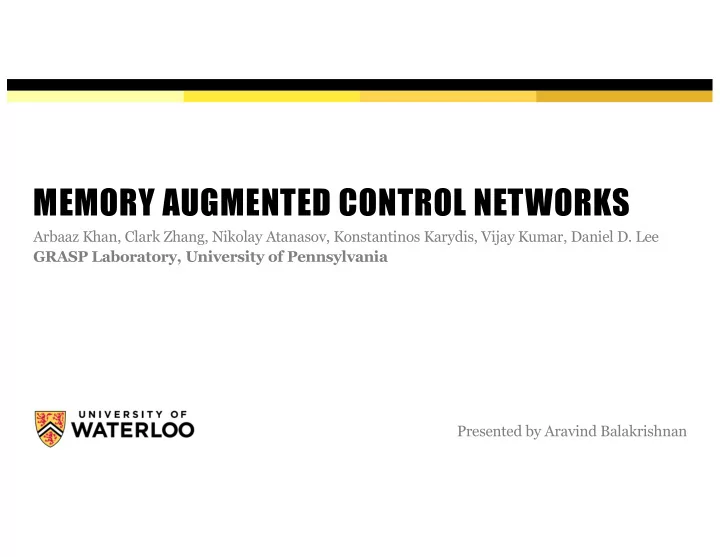

MEMORY AUGMENTED CONTROL NETWORKS Arbaaz Khan, Clark Zhang, Nikolay Atanasov, Konstantinos Karydis, Vijay Kumar, Daniel D. Lee GRASP Laboratory, University of Pennsylvania Presented by Aravind Balakrishnan
Introduction Partially observable environments with sparse rewards § Most real-world tasks § Needs history of observations and actions
The solution - MACN § Differentiable Neural Computer (DNC) § Neural network with differentiable external memory § maintains an estimate of the environment geometry § Hierarchical planning § Lower level: Compute optimal policy on local observation § Higher level: Local policy + local environment features + map estimation to generate global policy
Problem definition § States: , where is the goal state § Action: § Map : , -1 for tiles that are an obstacle § Local FOV : , 0 for non-observable tiles § Local observation : § Information available to agent at time, t: § The problem: Find mapping from to action
Value Iteration Networks (VIN) § Transition : § Reward : § MDP : VIN: Value Iteration approximated by a Convolutional Neural Network: Previous value function stacked with reward, passed through a Conv layer, max-pooled along channel and repeated K times is an approximation of value iteration over K iterations https://arxiv.org/abs/1602.02867
Differentiable Neural Computer (DNC) § LSTM (controller) with an external memory § Improved on Neural Turing Machine § Uses differential memory attention mechanisms to selectively read/write to external memory, M § Read : § Write : https://www.nature.com/articles/nature20101.epdf
Architecture – Conv block § Conv block: generate feature representation; R and initial V for VIN § Input : 2D map (m x n) stack with reward map (m x n) => (m x n x 2) § Convolve twice to get Reward layer (R) § Convolve once more to get initial V
Architecture - VI Module § First level of planning (Conv output into VIN) § VI module : Plan in this space and calculate optimal value function in K iterations § Input : R and V concatenated § Convolved to get Q; Take max channel-wise to get updated V § Perform this K times to get Value map
Architecture - Controller § Second level of planning (CNN output + VIN output into Controller): § Controller: § Input: VIN output + low level feature representation (from Conv) into controller § Controller network (LSTM) interfaces with memory § Output from controller and memory into linear layer to generate actions
Comparison with other work § Cognitive Mapping and Planning for Visual Navigation (Gupta et al. 2017) § Value iteration Network + memory § Maps image scans to 2D map estimation by approximating all robot poses § Neural Network Memory Architectures for Autonomous Robot Navigation (Chen et al. 2017) § CNN to extract features + DNC § Neural SLAM (Zhang et al. 2017) § SLAM model using DNC § Efficient exploration
Experiment Setup § Baselines: § VIN : just the VI module and no memory in place § CNN + DNC : CNN (4 Conv layers) extract features from observed map with the reward map and pass to the memory. § MACN with a LSTM: Planning module + LSTM instead of memory § DQN § A3C
Experiments – 2D Maze § CNN+Memory performance is very poor § MACN drop in accuracy on scaling is not as large as others
Experiments – 2D Maze with Local Minima § Only MACN generalizes to longer tunnels § Shift in memory states only when agent sees end of wall and on exit
Experiments – Graph Search § Blue node is the start state § Red node is end state § Agent can only observe edges connected to current node § Problem where state space and action space are not limited
Experiments – Continuous Control § Converts this to required 2D § Network output generates waypoints
Experiments – Other comparisons Convergence rate Scaling with complexity Scaling with memory
Conclusion and Discussion § Contributions: § Novel end-to-end architecture that combines hierarchical planning and differentiable memory § Future work § Efficient exploration § Take sensor errors into account
Recommend
More recommend